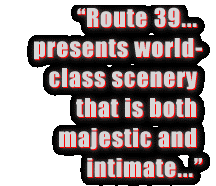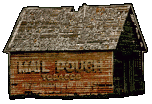|
four seasons
spring
summer
fall
rhumba.com |
 usicians who frequent a regional or national "circuit" see the same places over and over. After a while, things become familiar and treasured, like a daily commuter's secret favorite spots, privately admired every day on the way to work. Such places are the second of my three tiers. Some are exotic: Northern California's redwoods and sequoias, or the Barrier Island beaches just north of Charleston, South Carolina (or for that matter, Charleston itself). Most however are in the region closest to my home, the Eastern U.S. Mid-Atlantic. Route 39 out of Lexington, Virginia is in this region. Route 39 is a two-lane road which leaves Lexington on its way to
West Virginia, passing through both the Appalachian and Allegheny
mountains. Early on, it travels through Goshen Pass, Virginia where it
runs parallel to the Maury River and its large We would take Route 39 to get to the West Virginia ski resorts and other occasional gigs. The narrow road is both winding and steep. It presents world-class scenery that is both majestic and intimate, depending on which quarter-mile you happen to be driving. After descending from the mountains, passing through unincorporated
The Mail Pouch Tobacco Company was founded in Wheeling, West Virginia in 1879 by Aaron and Samuel Bloch. It was one of the largest and most well-known chewing tobacco concerns for the first half of this century. Thousands of the signs adorned the sides of barns throughout the United States. Barn owners would be paid annually to carry the advertisements. Many such barns are still standing, though they suffer increasingly from fading and other of time's effects. I looked forward to seeing this well-known example of Americana. Each time I passed it I would try and preserve the image, as if taking a photograph with which to remember the beautiful scene and the lonesome structure. The rickety barn looked forgotten, the faded Mail Pouch ad an echo of the past. I saw the barn as representing a simple, uncomplicated time. Given West Virginia's intense but sometimes stark natural beauty, one could easily buy into this, forgetting or perhaps unaware that life in the first half of this century was no less complicated than today, and arguably was more so, in dozens of ways. As if to remind me of this, every so often my romantic notion of the "forgotten past" would be curiously debunked by the sight of a freshly painted Mail Pouch barn. It was an illusion however. By 1969, the company (by then called Bloch Brothers and part of Swisher International) stopped repainting the barns, but kept one of the original Mail Pouch artists, Ohio painter Harley Warrick, in business repainting faded Mail Pouch ads. Until his retirement in 1992, Warrick had painted or repainted more than 20,000 barns in Appalachia and the Midwest. His affectionate tribute has helped the advertising iconography truly crossover and become American art.
NEXT ... |
|

 rapids; frothing water churning through
rock formations of impressive size, steepness and complexity. I once
nearly drowned in the rapids, a dumb college kid with an inner
tube.
rapids; frothing water churning through
rock formations of impressive size, steepness and complexity. I once
nearly drowned in the rapids, a dumb college kid with an inner
tube.